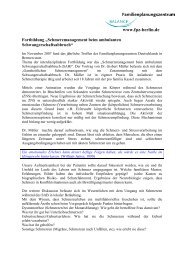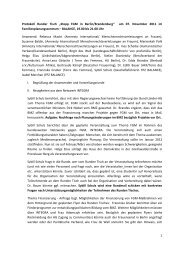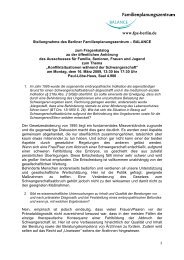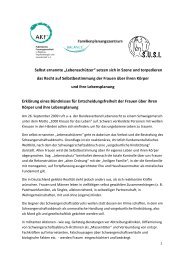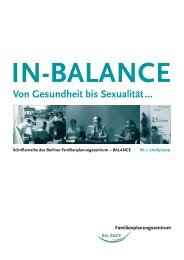Listening to African Voices - FPZ
Listening to African Voices - FPZ
Listening to African Voices - FPZ
Create successful ePaper yourself
Turn your PDF publications into a flip-book with our unique Google optimized e-Paper software.
5ResultsThe results chapter is organised in<strong>to</strong> eleven sections:• Immigrant populations from practicing countries in Hamburg(section 5.1);• Theoretical estimations about the numbers of women andgirls concerned in Hamburg (section 5.2);• Samples of the qualitative and quantitative survey (section5.3);• Knowledge, attitudes and practices of immigrant communitiesfrom Sub-Saharan Africa: an overview (section 5.4);• Knowledge, attitudes and practices of communities withmore than 100 immigrants in Hamburg 16 (section 5.5);• Knowledge, attitudes and practices of communities withless than 100 immigrants in Hamburg 16 (section 5.6);• Girls at risk in Hamburg (section 5.7);• Suggestions on how <strong>to</strong> promote the abandonment ofFGM/C among immigrant populations in Germany (section5.8);• Perceptions and practices regarding health care of <strong>African</strong>woman immigrants (section 5.9);• Results regarding media preferences of <strong>African</strong> communities(section 5.10);• Institutions working with <strong>African</strong> migrant communities inHamburg (section 5.11).The largest immigrant community in Hamburg by far is ofGhanaian origin, followed by those from Togo and Nigeria.The communities from these three countries represent about70% of the immigrant population from Sub-Saharan Africa.The table below displays the number of immigrants disaggregatedby sex for all communities for which DHS or MICSdata on FGM/C rates are available (25 Sub-Saharan countriesplus Egypt and Yemen).Table 2: Number of immigrants registered in Hamburg from FGM/Cpracticing countries 18No Country of origin Men Women Total1 Ghana 2418 2778 51962 Togo 847 684 15313 Egypt 857 392 12494 Nigeria 727 373 11005 Cameroon 270 213 4836 Gambia 333 117 4507 Cote d’Ivoire 250 153 4038 Kenya 77 208 2859 Benin 151 68 21910 Ethiopia 99 99 19811 Burkina Faso 154 36 19012 Sierra Leone 151 34 185The first two sections draw on official data sources and give13 Guinea 122 56 178an overview of how many immigrants from practicing countriesofficially live in Hamburg and how many women and14 Guinea Bissau 104 64 168girls are theoretically concerned when it comes <strong>to</strong> FGM/C.Section 5.3 <strong>to</strong> 5.9 explore primarily the data of the qualitativeand quantitative interviews with <strong>African</strong> communitymembers and other key informants.1516171819LiberiaSenegalNigerMaliSudan847470494146391421201291138470615.1. Overview of immigrant populations from practicingcountries in Hamburg 17According <strong>to</strong> the documentation of the Statistische Landesamtfür Hamburg und Schleswig Holstein (State Officeof Statistics for Hamburg and Schleswig Holstein), 15,712<strong>African</strong> immigrants were registered in Hamburg at the endof 2009. Among these 15,712 persons, 12,439 come from20212223242526EritreaTanzaniaUgandaYemenMauritaniaSomaliaChad2221922176330212678615242352925124countries where FGM/C is practiced. This number includes27 Central <strong>African</strong> Republic 1 0 1immigrants from Egypt and Yemen who were not includedTotal 6979 5514 12439in the current study. The number of immigrants from Sub-Saharan Africa is 11,305.The numbers in the table above include neither Germanpassport holders nor, evidently, men and women residing16 Where the practice of FGM/C is prevalent.17 Only including the countries where DHS or MICS data are available. 18 Where DHS/MICS data for FGM/C rates exist.<strong>Listening</strong> <strong>to</strong> <strong>African</strong> <strong>Voices</strong> 27






